Hearing aids are miniature electronic devices that sit in or on the ear. Hearing aids do not cure hearing loss, they amplify sounds you want to hear and reduce sounds you don’t. Today’s devices feature smart technology and a customized fit making them easy to use and practically unnoticeable.
Communication Needs Assessment
Loved ones are encouraged to attend this 60-minute appointment where Trinity Health providers test the patient’s ability to understand speech in a background of noise. After testing, they discuss the patient’s answers to a questionnaire about the level of motivation to improve hearing, the social and emotional impact of the hearing loss, lifestyle, interests, and communication goals.
Based on the information gathered, our team recommends the most appropriate technology and shows the patient what it looks like and how it works. If needed, a hearing aid or assistive device fitting will be scheduled.
We will also review the importance of improved communication strategies, aural rehabilitation, and realistic expectations with hearing aid use.
Hearing Aid Styles
Today’s hearing aids are smaller, more comfortable, and more effective than ever before. Even basic models today provide more features than the most advanced models available a few years ago.
In-the-Ear Styles
Hearing aids worn in the ear are custom-fit, meaning a mold of the ear is made and the hearing aid is built to fit the patient. These are available in different skin tones to blend in with the outer ear.
Completely-in-the-Canal (CIC)
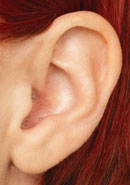 The smallest custom style, CIC instruments fit deeply and entirely within the ear canal. CIC instruments are designed to fit mild to moderate hearing losses. They are nearly invisible when worn. Even some of the smallest CIC instruments can now wirelessly connect to remote controls for volume and program changes if needed.
The smallest custom style, CIC instruments fit deeply and entirely within the ear canal. CIC instruments are designed to fit mild to moderate hearing losses. They are nearly invisible when worn. Even some of the smallest CIC instruments can now wirelessly connect to remote controls for volume and program changes if needed.
In-the-Canal (ITC)
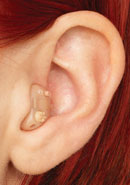 ITC instruments sit in the lower portion of the outer ear bowl, making them comfortable and easy to use. ITC instruments are slightly larger than CIC instruments, have a longer battery life, and can host additional features such as directional microphones for better understanding in noisy environments, and volume and/or program controls. ITC instruments are designed to fit mild to moderate hearing losses.
ITC instruments sit in the lower portion of the outer ear bowl, making them comfortable and easy to use. ITC instruments are slightly larger than CIC instruments, have a longer battery life, and can host additional features such as directional microphones for better understanding in noisy environments, and volume and/or program controls. ITC instruments are designed to fit mild to moderate hearing losses.
Half Shell (HS)
 Half shell models fill half the bowl of the outer ear. Like ITC models, their size enables the addition of features such as directional microphones, volume controls, and push buttons to activate special settings for different listening environments. Because of their size, they may be easier than smaller models to handle for some people and yet are still often disguised by hairstyles.
Half shell models fill half the bowl of the outer ear. Like ITC models, their size enables the addition of features such as directional microphones, volume controls, and push buttons to activate special settings for different listening environments. Because of their size, they may be easier than smaller models to handle for some people and yet are still often disguised by hairstyles.
Full Shell or In-the-Ear (ITE)
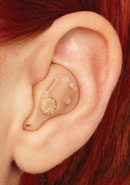 Full shell models fill the outer ear bowl. Their size allows the maximum number of additional controls and features such as directional microphones. They use a larger battery size and are more easily manipulated for individuals with dexterity concerns. ITE instruments size allow for a larger receiver with enough power designed to fit up to severe hearing losses.
Full shell models fill the outer ear bowl. Their size allows the maximum number of additional controls and features such as directional microphones. They use a larger battery size and are more easily manipulated for individuals with dexterity concerns. ITE instruments size allow for a larger receiver with enough power designed to fit up to severe hearing losses.
Behind-the-Ear Styles
Behind-the-Ear (BTE) models sit behind or on top of the outer ear, with tubing that sends sound down into the ear. BTEs come in a variety of colors to blend with hair or skin tones or stand out with stylish patterns. Different BTE sizes accommodate different features, controls, battery types and degrees of power.
Mini BTE with slim tube and tip
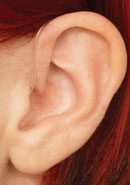 Mini BTE models house the microphones, internal circuits, and speaker of the hearing aid behind the ear in a very small case. Often times these hearing aids are very water and dust resistant. Mini BTE instruments are designed to fit mild to severe hearing losses.
Mini BTE models house the microphones, internal circuits, and speaker of the hearing aid behind the ear in a very small case. Often times these hearing aids are very water and dust resistant. Mini BTE instruments are designed to fit mild to severe hearing losses.
Receiver in canal (RIC)
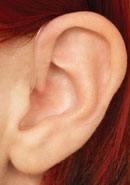 RIC models are mini BTEs that have the speaker of the instrument incorporated in the ear tip, instead of in the main body of the instrument. RIC instruments fit mild to severe hearing losses. This hearing aid style looks similar to the Mini BTE when worn on the ear.
RIC models are mini BTEs that have the speaker of the instrument incorporated in the ear tip, instead of in the main body of the instrument. RIC instruments fit mild to severe hearing losses. This hearing aid style looks similar to the Mini BTE when worn on the ear.
BTE with earmold
 BTEs with earmolds fit mild through profound hearing losses. They are larger and fit the contour of the ear. The earmold is custom made by taking an impression of an individual’s ear.
BTEs with earmolds fit mild through profound hearing losses. They are larger and fit the contour of the ear. The earmold is custom made by taking an impression of an individual’s ear.
Rechargeable
All BTE models and some custom models of hearing aids are rechargeable with up to 24 hours of use from one charge. These models are very helpful for people who have trouble changing batteries due to vision, coordination or mobility issues.
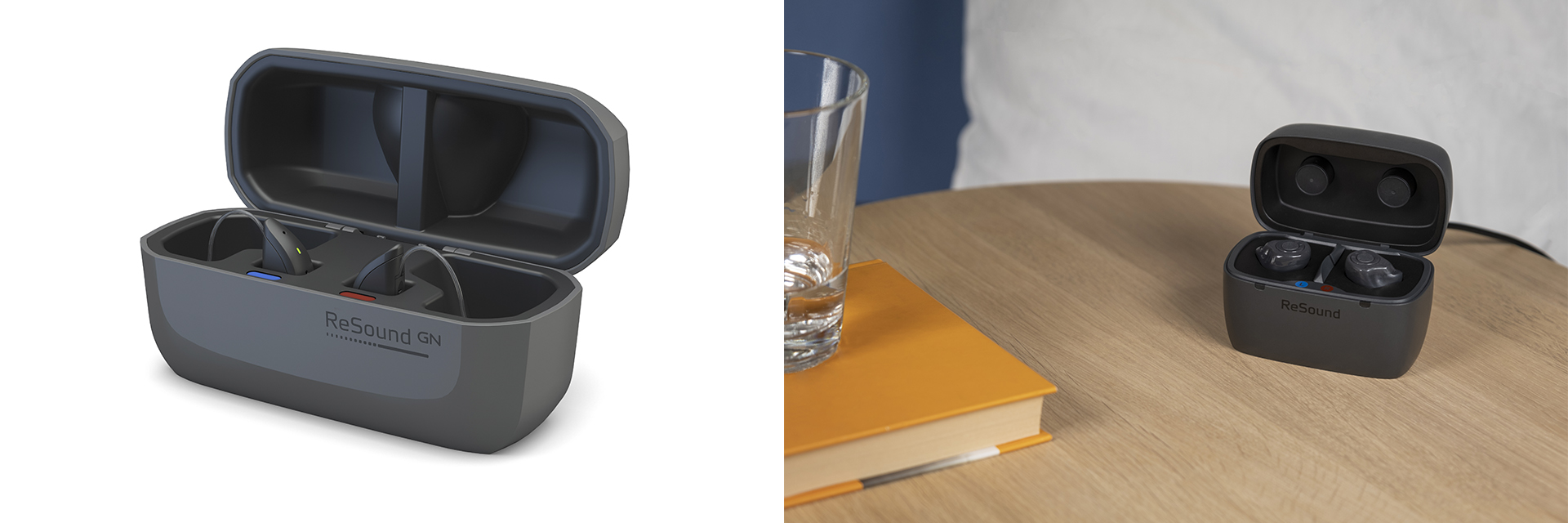
Over-the-Counter (OTC)
The FDA approved a new category of over-the-counter (OTC) hearing aids, enabling consumers with perceived mild to moderate hearing impairment to purchase hearing aids directly from stores or online retailers without the need for a medical exam, prescription or a fitting adjustment by an audiologist.
OTC hearing aids are available in our clinic and Trinity Health pharmacies. Our team will be here to help patients use and receive maximum benefit from these devices, as we do now with any make/model of hearing aid.
Hearing Aid Fitting
On the day of your hearing aid fitting, we will ensure the hearing aid fits your ear correctly and is comfortable. Your hearing aid will be programmed to meet your hearing loss prescription and verified through a series of tests called “real ear measures.” Our audiologists will then provide hearing aid orientation, demonstrate how to use the hearing aid, and explain the care and maintenance needed to keep your hearing aid in working order. A care kit and batteries are included with your hearing aid.
Because technology is only one part of treating hearing loss, you also receive the 5 Keys to Communication Success handbook. It provides practical, easy-to-implement strategies for improved communication around the home, on the phone, in the car, dining out and attending public events.
Following your hearing aid fitting, you begin a 60-day evaluation and adjustment period. If you do not feel you are receiving benefit with your hearing aid, you can try different technology or return the hearing aid during this timeframe. There is a $200 non-refundable fee for the services provided to you through the 60 days if you decide to return the hearing aid altogether.
Trinity Health audiology assistants will check in with you after your hearing aid fitting but before your first recheck appointment. At the recheck appointment, our audiologists will conduct speech-in-noise testing, ensure proper fit, sound quality, and that you are receiving benefit from your hearing aids. Device maintenance, connections to smartphones, cleaning and other topics may be covered.
Curious if your hearing aids are still the best option? You can visit https://www.hearingaidcheck.com/us to compare your performance with hearing aids to people with a cochlear implant. The results will reveal if you should consider other options for better hearing.
Accessories and Wireless Tech
Many hearing aid companies offer accessories that assist with hearing loss and maximize the benefit of hearing aids.
Apps
Many hearing aid manufacturers have cell phone apps. The app controls device settings like volume, program, noise reduction, bass/treble, wind noise reduction, speech focus and sound quality.
Smartphone connectivity
Many hearing aids can place phone calls through your hearing aids. This means you can talk on the phone without having to bring the phone to your ear.
Rechargeable
Lithium-ion rechargeable hearing aids are quickly replacing traditional battery-powered devices. The hearing aids go into a docking station overnight to charge and last anywhere from 14-22 hours before needing another charge.
Remote control
A remote control gives you the ability to turn the volume of the hearing aids up and down. It also allows access to specially designed programs for difficult listening environments like a restaurant.
Remote microphone
Remote microphones wirelessly communicate with your hearing aid. This allows you to clip the microphone near or on what you want to hear (on someone’s shirt or on the podium at a presentation for example). That input is then streamed directly into the hearing aids, eliminating background noise.
TV device
TV streaming devices allow you to stream stereo sound from your television directly to your hearing aid from 20-50 feet away. You can adjust the volume of your TV signal in your hearing aids to your preference and still hear conversations in the room. Others in your environment can either mute the television set or adjust the volume to their preferred level without impacting your ability to hear.
Artificial Intelligence (AI)
Some hearing aids are incorporating embedded sensors and artificial intelligence into their processing abilities. Potential uses include tracking daily hearing aid use, real-time language translation, troubleshooting technical issues, and even alerting designated people if you have a fall.
Financial Assistance
To better serve our patients, we itemized the cost of goods and services related to hearing healthcare costs. This information and your specific insurance benefits are discussed before scheduling a communication needs assessment visit.
If you do not have insurance coverage for hearing aids and need help paying for them, we can connect you with CareCredit for financing options as well as charitable community organizations.

